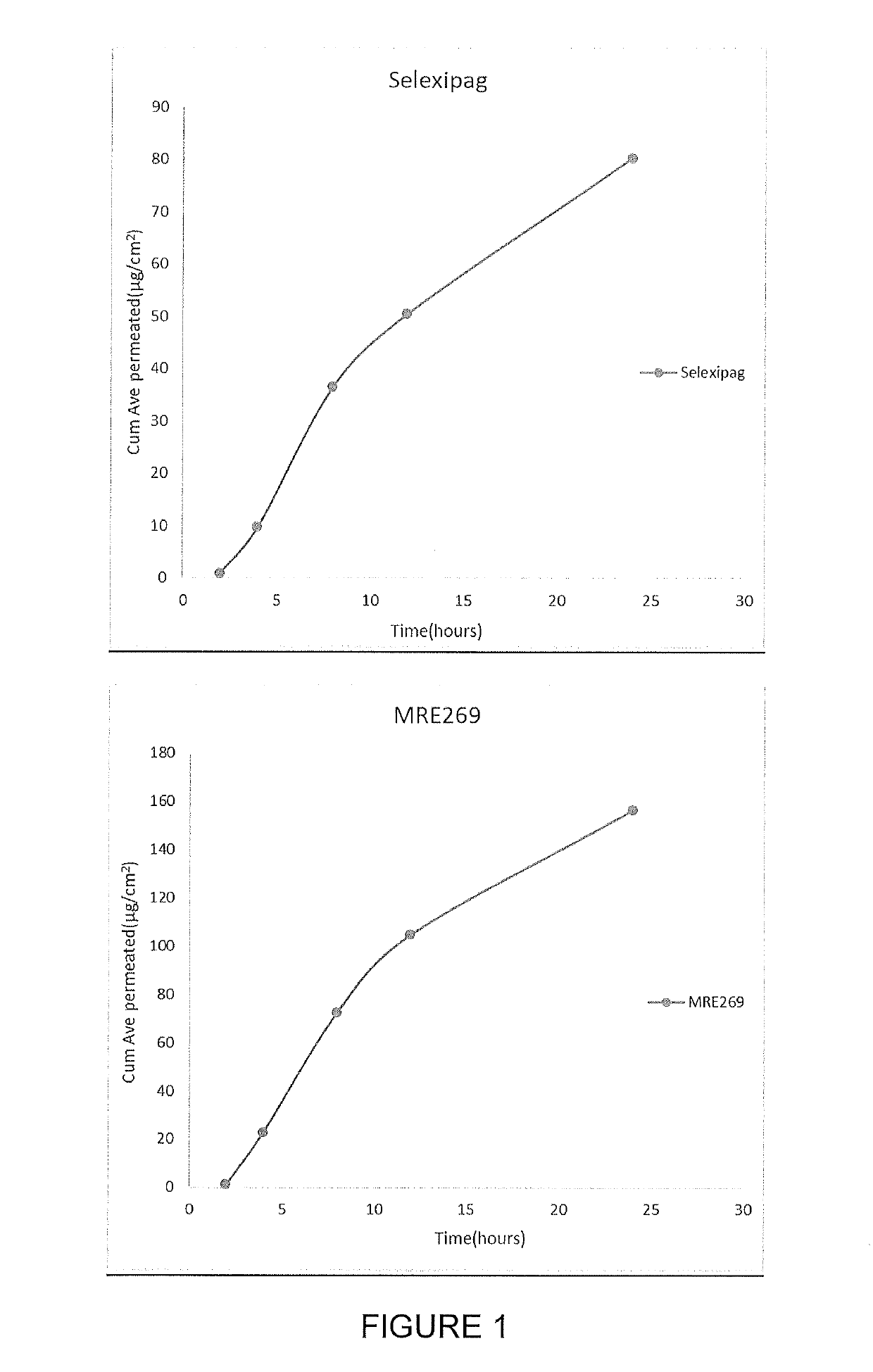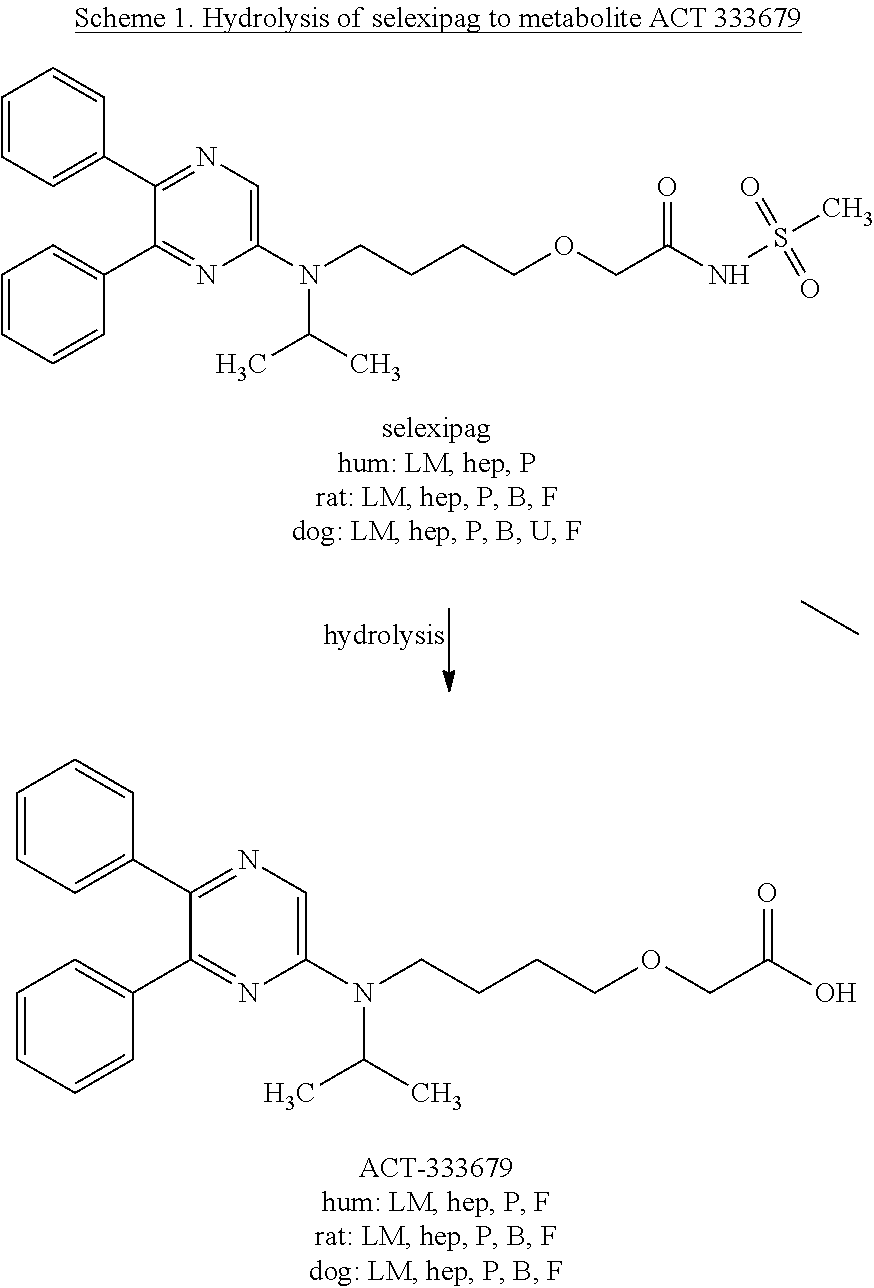Transdermal Delivery of Selexipag Metabolite
a metabolite and transdermal delivery technology, applied in the direction of pharmaceutical delivery mechanism, organic active ingredient, aerosol delivery, etc., can solve the problem that psa is not easy to modify
- Summary
- Abstract
- Description
- Claims
- Application Information
AI Technical Summary
Benefits of technology
Problems solved by technology
Method used
Image
Examples
example 1
Enhanced Skin Permeation of ACT 333679
[0032]One skin donor and three diffusion cells per formulation were used in these in vitro skin permeation experiments. Split thickness dermatomed (approximately at 375 μm) human cadaver skin was used to determine the permeation rate of the selexipag metabolite ACT 333679 in vitro. All in vitro skin permeation studies were conducted using the PermeGear Membrane Transport System (PermeGear, Inc., Hellertown, Pa.). Each Membrane Transport System consists of vertical, jacketed (37° C.±0.5° C.) Franz diffusion cells with magnetic stirrer and 1.7 cm2 diffusion area.
[0033]Skin flux studies were run for a period of 48 hours. At predetermined intervals (3, 24 and 48 hours) after starting the experiment, the entire contents of the receiver compartment were collected for determination of the ACT 333679 concentration by HPLC. The receiver compartment was refilled with fresh receiver medium. The receiver medium was pH 7.4 water with 0.44 mg / ml of OLETH 20 (...
example 2
Versus ACT 333679 In Vitro Enhanced Skin Permeation
[0037]One skin donor and three diffusion cells per formulation were used in these in vitro skin permeation experiments. The experiment was performed using the same instruments and methodologies as described in Example 1. Two formulations were prepared containing selexipag and ACT 333679 respectively. Formulation B shown in example 1 was used with this experiment because the enhancing system appeared to be more effective. Samples in the receptor phase were obtained at the 2, 4, 8, 12 and 24 hour intervals and the amount of selexipag or ACT333679 was determined by HPLC. The permeation values are shown in FIG. 1. At all the time points the permeation through skin of the ACT 333679 was higher than that of selexipag.
example 3
Unenhanced Skin Flux
[0038]One skin donor is used in these in vitro skin permeation experiments.
[0039]Split thickness dermatomed (approximately at 375 μm) human cadaver skin is used to determine the permeation rate of selexipag and metabolite ACT 333679 in vitro. All in vitro skin permeation studies are conducted using the PermeGear Membrane Transport System. Each Membrane Transport System consists of vertical, jacketed (37° C.±0.5° C.) Franz diffusion cells with magnetic stirrer.
[0040]Skin flux studies are run for a period of 168 hours. At predetermined intervals (24, 48, 72, 96, 120, 144, and 168 hours) after starting the experiment, the entire contents of the receiver compartment are collected for determination of the selexipag or ACT 333679 concentration by HPLC. The receiver compartment is refilled with fresh receiver medium. The solubility of the drugs in the receiver medium is sufficient to ensure sink conditions throughout each collection interval. The donor phase is composed...
PUM
| Property | Measurement | Unit |
|---|---|---|
| time | aaaaa | aaaaa |
| time | aaaaa | aaaaa |
| time | aaaaa | aaaaa |
Abstract
Description
Claims
Application Information
 Login to View More
Login to View More - R&D
- Intellectual Property
- Life Sciences
- Materials
- Tech Scout
- Unparalleled Data Quality
- Higher Quality Content
- 60% Fewer Hallucinations
Browse by: Latest US Patents, China's latest patents, Technical Efficacy Thesaurus, Application Domain, Technology Topic, Popular Technical Reports.
© 2025 PatSnap. All rights reserved.Legal|Privacy policy|Modern Slavery Act Transparency Statement|Sitemap|About US| Contact US: help@patsnap.com


